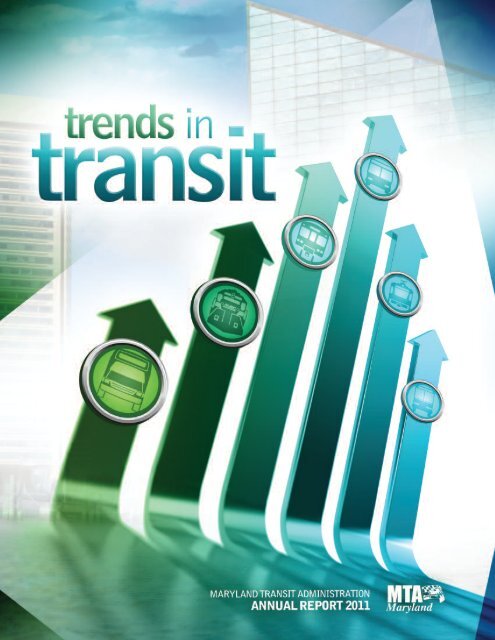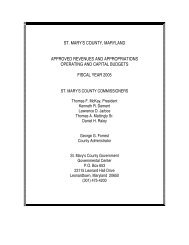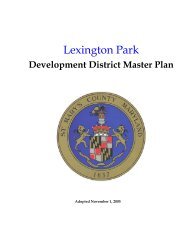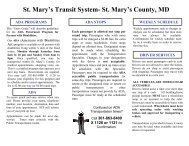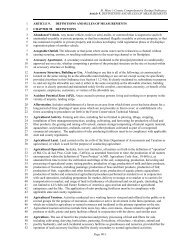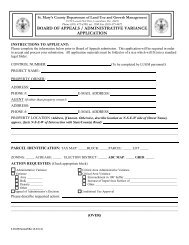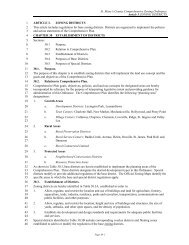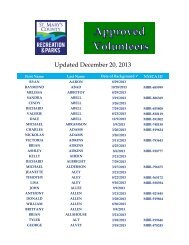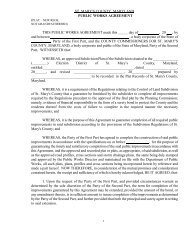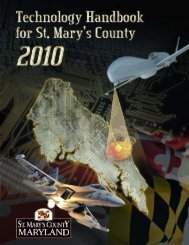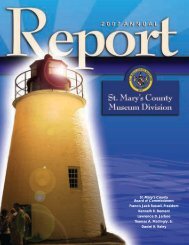MTA Annual Report - 2011 - Maryland Transit Administration ...
MTA Annual Report - 2011 - Maryland Transit Administration ...
MTA Annual Report - 2011 - Maryland Transit Administration ...
Create successful ePaper yourself
Turn your PDF publications into a flip-book with our unique Google optimized e-Paper software.
governor’s message | martin o’malley<br />
I am pleased to present the <strong>Maryland</strong> <strong>Transit</strong> <strong>Administration</strong>’s<br />
<strong>Annual</strong> <strong>Report</strong>. Our state is committed to providing easily<br />
accessible, high quality public transportation. In today’s<br />
economy, transit is a wise and often necessary service that<br />
helps create opportunities and a better future for hundreds<br />
of thousands of people in <strong>Maryland</strong>. The <strong>Maryland</strong> <strong>Transit</strong><br />
<strong>Administration</strong> is dedicated to delivering safe, efficient<br />
transportation to ensure that <strong>Maryland</strong>ers have the ability<br />
to go places. Every day, <strong>MTA</strong> employees work hard to<br />
maintain and operate our existing infrastructure, and plan<br />
for the next generation of transit that will greatly impact the<br />
future of our state. Equally important are our efforts to replace<br />
older, less-efficient equipment with new hybrid powered buses and<br />
“green” diesel locomotives. We are also creating transit-oriented development to address<br />
growth by building more sustainable, walkable communities around our existing transit<br />
stations. These actions are good for the environment and good for our people. Thank you for<br />
your interest in <strong>Maryland</strong>’s transit services. By working together, we can ensure that we<br />
continue to make steady progress for safe, clean, efficient transportation.<br />
secretary’s message | beverley swaim-staley<br />
Every day, people trust the <strong>Maryland</strong> <strong>Transit</strong> <strong>Administration</strong> to get<br />
them where they need to go. With average daily ridership up six<br />
percent from last year, the agency plays a crucial role in<br />
reducing traffic congestion and air pollution by providing safe,<br />
convenient and affordable public transit service. To<br />
accommodate this increased ridership, the <strong>Maryland</strong><br />
Department of Transportation supports the <strong>MTA</strong>’s efforts to<br />
secure federal grants and invest in infrastructure, new hybrid<br />
buses, bi-level MARC Train cars, and station and facility<br />
upgrades. Federal <strong>Transit</strong> <strong>Administration</strong> approval for the<br />
proposed Red and Purple Light Rail lines in <strong>2011</strong> means we can<br />
now move forward with the preliminary engineering and<br />
environmental planning that will take us one step closer to construction.<br />
Investments and improvements to public transportation and projects like these will help to meet<br />
tomorrow’s transportation needs, as well as create tens of thousands of new jobs in the more<br />
immediate future. These efforts and those of over 3,000 dedicated employees of the <strong>MTA</strong> not only<br />
address these needs, but are a vital component to enhancing the quality of life in <strong>Maryland</strong>.<br />
TRENDS IN TRANSIT
administrator’s message | ralign t. wells<br />
I am pleased to share this year’s “Trends in <strong>Transit</strong>” <strong>2011</strong> <strong>Annual</strong><br />
<strong>Report</strong> with you. The rise in <strong>MTA</strong>’s ridership reflects not only the<br />
increased cost of fuel, but the confidence that our customers have<br />
in <strong>MTA</strong>’s high standards of safety and reliability. The guiding<br />
principles for <strong>MTA</strong> improvements and plans for the future are to<br />
meet this ever-increasing demand while addressing the need to<br />
minimize costs immediately and over the long term. We’re<br />
proud of the progress we’ve made in reaching those challenging<br />
goals. For instance, the <strong>MTA</strong> continues to add hybrid buses that<br />
are over 20 percent more fuel efficient than older ones. Each year<br />
we save over 400,000 gallons of fuel in this way, for an annual<br />
savings of $1,640,000. Solar panels recently installed on the roof of<br />
one of <strong>MTA</strong>’s bus divisions is projected to save an additional $68,200 per<br />
year. New energy-efficient LED lighting in the Metro Subway stations and lighting renovations<br />
throughout all <strong>MTA</strong> facilities are saving another $434,000 annually. These are just a few of the<br />
many ways <strong>MTA</strong> continues to meet increased demand while lowering operating costs. Thanks to all<br />
of our dedicated employees for the tremendous work they do each day by delivering safe and reliable<br />
transportation to the citizens and visitors of <strong>Maryland</strong>.<br />
message | from the employees<br />
We are the face of the <strong>MTA</strong>. Whether we’re starting each<br />
customer’s day with a smile, or just getting every one of<br />
them to where they’re going safe and sound, it’s our goal<br />
to make every part of their trip as pleasant as possible.<br />
That’s a responsibility we take seriously. Of course,<br />
customer safety is number one with us, and always will be.<br />
But we know – and we’re reminded every day – that<br />
extraordinary customer service makes our job rewarding<br />
in ways that can’t be measured. Talk to one of us about<br />
working at <strong>MTA</strong> and you’re likely to hear about our<br />
“family” atmosphere. That means we support each other<br />
in ways large and small, and look for ways to help each<br />
other and our customers. Not just because that’s <strong>MTA</strong><br />
policy. It’s because we know that serving our fellow<br />
travelers – our friends, neighbors, families and customers<br />
– makes for a more satisfying day, every day.<br />
MARYLAND TRANSIT ADMINISTRATION | ANNUAL REPORT <strong>2011</strong> 3
customer<br />
service trends<br />
Ongoing improvements in customer service are an<br />
integral part of delivering quality public<br />
transportation. In <strong>2011</strong> <strong>MTA</strong> opened its first<br />
satellite customer information booth at the<br />
Mondawmin <strong>Transit</strong> Center, where the second busiest<br />
Metro Subway station is located, and which connects<br />
with eleven different Local Bus lines. The booth is<br />
staffed seven days a week by <strong>Transit</strong> Information<br />
agents, and with an Automatic Vehicle Locator right<br />
inside, changes or delays in service can be tracked,<br />
offering customers real-time information.<br />
trends in FY<strong>2011</strong><br />
▲<br />
▲<br />
▲<br />
▲<br />
▲<br />
▲<br />
Opening of first satellite customer information center<br />
at Mondawmin Station<br />
Rate Your Ride moves to <strong>MTA</strong> (using cell phone text<br />
messages to turn feedback into service improvements)<br />
Expansion of Guaranteed Ride Home program<br />
redefines riders’ relationship to public transit<br />
Increased use of CharmCard (now includes seniors<br />
and disability customers)<br />
Expanded hours at Call Center during emergencies<br />
Expanded use of social media as a valued customer<br />
service tool<br />
TRENDS IN TRANSIT
Other improvements included the expansion of the Guaranteed<br />
Ride Home program, which now covers the entire <strong>MTA</strong> service<br />
area; management of the Rate Your Ride program in which rider<br />
feedback is gathered to help guide improvements; expanded<br />
hours of live transit information during major special events<br />
and emergencies in the <strong>Transit</strong> Information Contact Center;<br />
expanded use of social media as a customer service tool; the<br />
inclusion of seniors and disability customers for the new<br />
CharmCard, <strong>MTA</strong>’s new electronic fare collection system, and<br />
the inclusion of an “autoload” feature to help customers easily<br />
add value to their card; enhancement of the <strong>MTA</strong> website enabling customers who have a<br />
lost or stolen CharmCard to automatically transfer the remaining value to a new card; the<br />
new S-PASS for students, now being tested at select schools, which will make travel for<br />
Baltimore’s students more efficient and secure; and the addition of “Audio Now,” which<br />
enables customers to hear time-saving radio and television service updates from the <strong>MTA</strong><br />
<strong>Transit</strong> Team from the convenience of their own phone.<br />
ONGOING IMPROVEMENTS IN CUSTOMER SERVICE<br />
ARE AN INTEGRAL PART OF DELIVERING<br />
QUALITY PUBLIC TRANSPORTATION.<br />
MARYLAND TRANSIT ADMINISTRATION | ANNUAL REPORT <strong>2011</strong> 5
local bus trends<br />
Ridership on Local Bus rose four percent in Fiscal Year<br />
<strong>2011</strong>, and now provides over 240,000 rides a day. To<br />
provide better customer service and increase operating<br />
efficiency, more hybrid buses were ordered, many routes<br />
were streamlined and more articulated buses were<br />
added on some of our busiest routes.<br />
trends in FY<strong>2011</strong><br />
▲<br />
▲<br />
▲<br />
▲<br />
▲<br />
▲<br />
Increased training for Operators (Bus Mentoring Program)<br />
Increased number of hybrids on the street ($8.4 million<br />
Federal grant/more ordered as more are retired)<br />
Streamlining of routes (more articulated buses added on<br />
busiest routes)<br />
S-PASS (Pilot program at select schools making travel more<br />
secure and efficient for students)<br />
Replacement of shelters on Howard Street (two-part<br />
initiative including new Lexington Light Rail Stop)<br />
Safety (testing of Safe Turn Alert system to enhance<br />
pedestrian safety)<br />
TRENDS IN TRANSIT
In October <strong>2011</strong> the <strong>MTA</strong> received an $8.4 million grant from<br />
the U.S. Department of Transportation to purchase new hybrid<br />
buses. The 57 new “Excelsior” buses ordered represent the next<br />
generation of hybrid buses and have greater seating capacity<br />
and many new safety features. These new fuel-efficient buses<br />
now comprise nearly one-third of the entire local bus fleet,<br />
which will be totally hybrid before the end of the decade. To help<br />
address the increase in ridership, several new 60-foot articulated hybrid buses were also<br />
added to some of <strong>MTA</strong>’s busiest routes to help alleviate overcrowding. To enhance<br />
pedestrian safety, the <strong>MTA</strong> began testing the “Safe Turn Alert” system, an automated voice<br />
system that tells pedestrians, operators and passengers when a bus is turning a corner. A<br />
mentoring program was also introduced to help foster a strong internal support system in<br />
which bus operators can learn about additional training opportunities, address concerns and<br />
discuss strategies for improving interactions with customers.<br />
4%<br />
RIDERSHIP ON LOCAL BUS ROSE FOUR PERCENT<br />
IN FISCAL YEAR <strong>2011</strong>, AND NOW PROVIDES<br />
OVER 240,000 RIDES A DAY.<br />
MARYLAND TRANSIT ADMINISTRATION | ANNUAL REPORT <strong>2011</strong> 7
light rail trends<br />
Continuous improvement in the safety and utility of our Light Rail<br />
service is more than a trend at <strong>MTA</strong>. It’s our everyday approach. While<br />
many of the improvements made to the Light Rail line and operation<br />
were behind the scenes during <strong>2011</strong>, Hurricane Irene in August spurred<br />
the development of a comprehensive vegetation management program –<br />
with the advice and consent of Baltimore’s Cylburn Arboretum – that<br />
takes a proactive approach to trimming trees that impede operator<br />
vision or threaten overhead catenary power lines.<br />
trends in FY<strong>2011</strong><br />
▲<br />
▲<br />
▲<br />
▲<br />
New Public Address communications system installed<br />
at all Light Rail stops for clearer announcements<br />
Installation of new Closed Circuit TV systems begun at<br />
Light Rail stops for increased patron safety and better<br />
police monitoring<br />
New safety system and protocols initiated to reduce<br />
injuries to maintenance staff<br />
The North Avenue Switch Project replaced all yard<br />
switches with new powered switches as the first step<br />
toward full automation of the yard<br />
TRENDS IN TRANSIT
To improve connectivity between the Light Rail,<br />
Local Bus and Metro Subway modes, we initiated<br />
the relocation of the southbound Lexington Market<br />
stop so it would be directly across from the northbound<br />
Light Rail platform and better aligned with the<br />
Lexington Market Metro Subway Station. Its new<br />
design is a particularly welcome improvement for our<br />
disabled patrons. The project included the removal of<br />
four arch structures that supported the overhead<br />
catenary lines along Howard Street and the installation<br />
of several new lighted bus shelters. Finally, to highlight the fact that safety is the number one<br />
priority for our customers, an aggressive rail safety public outreach campaign in <strong>2011</strong> also<br />
helped to foster a sharp 20 percent decline in accidents near <strong>MTA</strong> Light Rail tracks.<br />
20%<br />
AN AGGRESSIVE RAIL SAFETY PUBLIC<br />
OUTREACH CAMPAIGN IN <strong>2011</strong> HELPED TO<br />
FOSTER A SHARP 20 PERCENT DECLINE IN<br />
ACCIDENTS NEAR <strong>MTA</strong> LIGHT RAIL TRACKS.<br />
MARYLAND TRANSIT ADMINISTRATION | ANNUAL REPORT <strong>2011</strong> 9
marc train<br />
trends<br />
The trend to leave the car in the driveway<br />
and take transit to work was also felt at<br />
MARC Train, where ridership rose about two<br />
percent last year. Last November the Board<br />
of Public Works gave approval for MARC to<br />
invest $153 million for 54 new bi-level<br />
passenger cars with delivery planned to<br />
begin in spring 2013.<br />
trends in FY<strong>2011</strong><br />
▲<br />
▲<br />
New bi-level cars increase seating capacity<br />
Completion of new platforms, elevators and<br />
walkways at BWI Rail Station offers greater<br />
customer convenience and increased connectivity<br />
with ICC buses<br />
TRENDS IN TRANSIT
The new cars have greater<br />
seating capacity than those they<br />
are replacing, and will have a<br />
useful life of up to 40 years.<br />
When they come online, <strong>MTA</strong><br />
will replace 38 cars. Overall, the<br />
fleet will expand by 16 cars,<br />
which will help accommodate<br />
rising ridership and relieve<br />
overcrowding on some of the<br />
busier routes. Revisions in the<br />
Penn Line schedule last year<br />
also added more frequent service and an additional 1,000 seats during rush-hour service,<br />
reducing the number of standees. On-time performance on that line increased to 93 percent.<br />
93%<br />
SCHEDULE REVISIONS ON THE PENN LINE<br />
HELPED REDUCE THE NUMBER OF<br />
STANDEES. ON-TIME PERFORMANCE ON<br />
THAT LINE INCREASED TO 93 PERCENT.<br />
MARYLAND TRANSIT ADMINISTRATION | ANNUAL REPORT <strong>2011</strong> 11
metro subway<br />
trends<br />
Ridership on Metro Subway increased nearly eight percent in Fiscal<br />
Year <strong>2011</strong>, providing over 48,000 rides daily. To help communicate<br />
better with customers, several new Metro Subway pylons were installed<br />
in the 14-station Metro Subway system using high efficiency LED<br />
lighting. The modern-style pylons feature two backlit informational<br />
signs showing bus and rail connections and a detailed map of the<br />
neighborhood showing attractions within walking distance of each<br />
station. Many lighting fixtures were also upgraded, renovated or<br />
replaced with more efficient ones at Metro Subway stations and<br />
facilities, saving <strong>MTA</strong> thousands of dollars every year in energy costs.<br />
trends in FY<strong>2011</strong><br />
▲<br />
▲<br />
▲<br />
▲<br />
New pylons installed (three completed)<br />
Better connectivity at Lexington<br />
Market Station with Light Rail<br />
Fire Security System renovated<br />
Facility lighting renovations save<br />
money and energy<br />
TRENDS IN TRANSIT
Fire Safety Trends<br />
Safety in Metro Subway stations has<br />
always been a top priority. Last April<br />
the <strong>MTA</strong> was recognized nationally with<br />
the prestigious American Transportation<br />
Award for the Northeast Region for our<br />
project to replace and upgrade the fire<br />
protection system. Panelists representing<br />
the business community, police and/or<br />
emergency workers and transportation<br />
experts from the University Transportation Centers judged entries at both the regional<br />
and national levels. The project, completed in December 2010 six months ahead of<br />
schedule, refurbished or replaced many of the aging control and ventilation systems in<br />
the Baltimore Metro Subway system.<br />
8%<br />
RIDERSHIP ON METRO SUBWAY INCREASED<br />
NEARLY EIGHT PERCENT IN FISCAL YEAR <strong>2011</strong>,<br />
PROVIDING OVER 48,000 RIDES DAILY.<br />
MARYLAND TRANSIT ADMINISTRATION | ANNUAL REPORT <strong>2011</strong> 13
commuter bus<br />
trends<br />
Commuter Bus ridership rose nearly six percent in Fiscal Year <strong>2011</strong> and<br />
continues to climb even higher as gas prices remain high. To accommodate<br />
new jobs created by BRAC (Base Realignment and Closure) and improve<br />
connectivity with MARC Train and Washington area transit services, <strong>MTA</strong><br />
introduced the new 200-series buses, and usage of these routes has been growing<br />
steadily each month. The 200-series Commuter Buses stop at Park & Ride lots and<br />
travel along the new Inter County Connector toll road (ICC) to connect commuters in<br />
Howard, Prince George’s and Montgomery counties with key employment centers. To assist<br />
commuters in the growing Southern <strong>Maryland</strong> region, <strong>MTA</strong> introduced the 906 Commuter Bus in<br />
November, which offers service between Waldorf and Washington, DC. The Prince Frederick Park &<br />
Ride in Calvert County that serves Southern <strong>Maryland</strong> commuters using the No. 902 Commuter Bus<br />
was also enlarged, doubling the parking spaces from 200 to 400.<br />
trends in FY<strong>2011</strong><br />
▲<br />
▲<br />
▲<br />
▲<br />
ICC Bus ridership trend shows increase each month<br />
since inception; three new routes added<br />
Prince Frederick Park & Ride doubles parking spaces<br />
for commuters using the No. 902<br />
Base Realignment and Closure Planning improves<br />
access to Fort Meade<br />
Expansion of Guaranteed Ride Home Program now<br />
covers entire service area<br />
TRENDS IN TRANSIT
“I like taking <strong>MTA</strong> Commuter Bus<br />
because I work in the city<br />
and it takes me from the Park & Ride<br />
in Columbia right to the front door of<br />
my building. I also like the fact that it<br />
is affordable and saves me a lot of<br />
money that I would normally have to<br />
spend on gas and parking if I drove in.<br />
It is reliable and always on time, and<br />
with a young child this is especially<br />
important to me so I can plan my<br />
schedule around his.”<br />
– Anita O.<br />
6%<br />
COMMUTER BUS RIDERSHIP ROSE NEARLY SIX<br />
PERCENT IN FISCAL YEAR <strong>2011</strong> AND CONTINUES<br />
TO CLIMB EVEN HIGHER.<br />
MARYLAND TRANSIT ADMINISTRATION | ANNUAL REPORT <strong>2011</strong> 15
mobility<br />
trends<br />
Ridership on Mobility, combined with Taxi<br />
Access service, rose over 12 percent in Fiscal<br />
Year <strong>2011</strong>. To help accommodate this increased<br />
demand for paratransit services and improve<br />
customer service, <strong>MTA</strong> Mobility launched<br />
Mobility Direct in March <strong>2011</strong>. Mobility Direct<br />
is an Interactive Voice Response (IVR) system<br />
that allows Mobility customers to manage their<br />
account any time of day or night.<br />
trends in FY<strong>2011</strong><br />
▲<br />
▲<br />
▲<br />
▲<br />
New IVR Mobility Direct phone system<br />
helps patrons to better manage<br />
their accounts<br />
Increased community outreach activities<br />
help customers understand new geographic<br />
service changes and other improvements<br />
Conditional Eligibility defined to help<br />
lower operating cost<br />
Individually tailored travel training<br />
program enhanced to encourage use of<br />
fixed-route service<br />
TRENDS IN TRANSIT
Mobility Direct is a new interactive<br />
voice response telephone option that<br />
helps patrons manage their accounts,<br />
receive reminder calls, and cancel<br />
scheduled pickups. This new service is<br />
available by touch-tone telephone 24<br />
hours a day, and is offered in addition<br />
to live operator assistance from Call<br />
Center agents. An outreach campaign<br />
to all Mobility customers in <strong>2011</strong> also<br />
helped define new guidelines on<br />
eligibility and geographic service area<br />
changes since many Local Bus routes<br />
had changed. Another outreach campaign was focused on travel training to help individuals<br />
with disabilities and older adults become more familiar with and aware of the flexibility and<br />
accessibility of fixed-route transit, including Local Bus, Metro Subway and Light Rail.<br />
12%<br />
RIDERSHIP ON MOBILITY, COMBINED WITH<br />
TAXI ACCESS SERVICE, ROSE OVER 12<br />
PERCENT IN FISCAL YEAR <strong>2011</strong>.<br />
“Travel Training helped me to better<br />
navigate through all the various<br />
<strong>MTA</strong> options. To get to my job at<br />
Social Security, I first take either<br />
paratransit or a local Howard<br />
County bus to the Park & Ride to<br />
board a Commuter Bus to<br />
Baltimore. Then I transfer to the<br />
40 QuickBus downtown which then<br />
takes me the rest of the way to<br />
Woodlawn. I recommend Travel<br />
Training to anyone who is sightimpaired<br />
who wishes to learn more<br />
about riding <strong>MTA</strong> services.”<br />
– Darlene B.<br />
MARYLAND TRANSIT ADMINISTRATION | ANNUAL REPORT <strong>2011</strong> 17
mta police<br />
force trends<br />
Thanks in large measure to the extraordinary<br />
efforts of the men and women of the <strong>MTA</strong> Police<br />
Force, by the end of <strong>2011</strong> there was a 10<br />
percent reduction in Part 1 crimes. Additionally,<br />
over a five-year period, crime has been reduced<br />
by 40 percent on the <strong>MTA</strong> transit system.<br />
10%<br />
BY THE END OF <strong>2011</strong> THERE WAS A 10<br />
PERCENT REDUCTION IN PART 1 CRIMES.<br />
This downward trend in criminal activity is a result of the<br />
<strong>MTA</strong> Police Force’s use of enhanced technologies, such as<br />
the new Police Monitoring Facility; the Police Department’s<br />
use of computer statistics (CompStat) that is used on a<br />
weekly basis to manage resources and deter crime; and the<br />
deployment of Operation ZEUS, a nationally-recognized<br />
program instituted to target-harden facilities to mitigate the<br />
possibility of a terrorist attack and suppress crime. Several<br />
capital projects were also completed: new 36,000 square<br />
foot Police Headquarters and Northern Complex that houses<br />
the Police Monitoring Facility and Emergency Operations<br />
Center; new structure to house the Mobile Communication<br />
& Command Vehicle; a modern Canine Facility with indoor<br />
and outdoor kennels; and the renovation of its Southern<br />
Police District. There was also a downward trend in<br />
departmental vehicle accidents by 24 percent compared to<br />
2010, due in large part to an emphasis on training and an<br />
increased level of accountability by police supervisors.<br />
TRENDS IN TRANSIT
social media trends<br />
The <strong>MTA</strong> is committed to first-class customer service in the way it<br />
communicates with and responds to our riders. Our website<br />
(mta.maryland.gov), various micro-sites, social media websites,<br />
email/text alerts, blog and RSS feeds allow us to convey<br />
information and respond to customer concerns quickly, utilizing<br />
communications technology that reaches our riders in the ways<br />
they prefer to receive information. This ongoing online<br />
dialogue with our customers has proven to be both efficient<br />
and appreciated by our customers, and a welcome addition<br />
to our customer service approach.<br />
THE <strong>MTA</strong> FACEBOOK AND TWITTER SITES SERVE OVER<br />
4,300 ACTIVELY ENGAGED USERS EACH MONTH.<br />
Use of the <strong>MTA</strong> website is strong and growing, with over 2.5<br />
million page views per month. Our social media audience<br />
numbers continue to grow steadily as well. The <strong>MTA</strong> Facebook<br />
and Twitter sites serve over 4,300 actively engaged users who<br />
follow and respond to <strong>MTA</strong> feeds each month. “Re-tweets”<br />
and re-postings by news organizations and other media<br />
outlets that count on <strong>MTA</strong> social media for the latest and<br />
most accurate transit information have been shown to<br />
increase that number significantly. One indication of the<br />
success of our approach is that transit agencies across<br />
the nation have contacted <strong>MTA</strong> for advice regarding<br />
implementation of their own social media programs.<br />
MARYLAND TRANSIT ADMINISTRATION | ANNUAL REPORT <strong>2011</strong> 19
green trends<br />
In <strong>2011</strong> a massive project to replace electric fixtures<br />
and bulbs with greener, more energy-efficient<br />
components was undertaken in 54 different <strong>MTA</strong><br />
locations. Areas addressed include bus and rail<br />
facilities and maintenance shops, the Frederick<br />
fueling facility, the two MARC garages at BWI Rail<br />
Station and the Operations Control Center in<br />
Baltimore City. Fluorescent fixtures were retrofitted<br />
and upgraded, incandescent lamps were replaced with<br />
compact fluorescents, and many Metro Subway exit signs<br />
were replaced with new LED signs with battery backups. The<br />
energy saved from these 14,144 individual lighting renovations<br />
translates to a combined savings of over $434,000 per year.<br />
trends in FY<strong>2011</strong><br />
▲<br />
▲<br />
▲<br />
▲<br />
More hybrid buses were added, reducing<br />
pollution and saving significant amounts of<br />
fuel each year<br />
Solar panels added to roof at Northwest<br />
Bus Division with grants from MD<br />
Energy Program<br />
Increased use of CharmCard cuts down<br />
on paper/magnetic tickets<br />
Electrical renovations throughout <strong>MTA</strong><br />
system saves money and energy<br />
TRENDS IN TRANSIT
Solar Panels at Northwest Bus Division<br />
Going green saves some green too! A<br />
project that began in November 2010 to<br />
install a series of 3,707 “thin film” solar<br />
panels on the roof of Northwest Bus<br />
Division is now complete. The solar<br />
energy generated by the panels supply<br />
18 percent of the electricity needed at<br />
Northwest and help supplement power<br />
used for lights, HVAC, outlets and<br />
more. The solar power is directed to a<br />
bi-directional meter and subtracted from<br />
the monthly electric bill. Expected savings<br />
for the <strong>MTA</strong> will be $68,200 per year.<br />
THE ENERGY SAVED FROM THESE 14,144 INDIVIDUAL<br />
LIGHTING RENOVATIONS TRANSLATES TO A COMBINED<br />
SAVINGS OF OVER $434,000 PER YEAR.<br />
MARYLAND TRANSIT ADMINISTRATION | ANNUAL REPORT <strong>2011</strong> 21
future trends<br />
Moving Forward with the Red Line<br />
Last October the proposed Red Line, a 14.1-mile, 19-station Light Rail<br />
system that will run from the Johns Hopkins Bayview Medical Campus east<br />
of Baltimore to the Social Security <strong>Administration</strong> and CMS/Centers for<br />
Medicare and Medicaid Service west of Baltimore, was named by<br />
President Obama as one of 14 infrastructure projects across the country<br />
that would receive expedited environmental review to help create new jobs<br />
quickly. By engaging and optimizing early negotiations with all necessary<br />
federal agencies, the Red Line could potentially begin construction earlier<br />
than planned. The Red Line would connect all forms of Baltimore City<br />
transit routes, including MARC Train, Metro Subway, Local and Commuter<br />
Bus, Light Rail and the Charm City Circulator.<br />
trends in FY<strong>2011</strong><br />
▲<br />
▲<br />
▲<br />
FTA approval for Red and Purple<br />
Line (moving forward with<br />
preliminary engineering)<br />
Consolidation of Operations Control<br />
Center for better monitoring of vehicles<br />
Planning moves forward for the Corridor<br />
Cities <strong>Transit</strong>way and materials sent to<br />
FTA for review and consideration<br />
TRENDS IN TRANSIT
FTA Approval for the Purple Line<br />
The Federal <strong>Transit</strong> <strong>Administration</strong> (FTA) gave <strong>MTA</strong> approval<br />
in October <strong>2011</strong> to move forward with preliminary engineering<br />
on the proposed Light Rail Purple Line, meaning that the<br />
project can now prepare more detailed plans, cost estimates<br />
and environmental studies. Besides linking both branches of<br />
Washington Metro’s Red Line at Bethesda and Silver Spring, the Green Line at College Park<br />
and the Orange Line at New Carrollton, the Purple Line would also connect with all three<br />
MARC Train lines, Amtrak and Local Bus services. In November the <strong>MTA</strong> held a series of<br />
Open Houses during which community members learned about the benefits of the Purple Line,<br />
got status updates, and were invited to offer input and find out about future plans.<br />
New Center Will Consolidate <strong>MTA</strong> Operations<br />
In October <strong>2011</strong> the Board of Public Works approved a $15.4 million contract for a project<br />
to consolidate the electronic control systems for Local Bus, Light Rail and Metro Subway<br />
under one roof on the second floor at the current Operations Control Center building at Eutaw<br />
and Saratoga streets. With sophisticated vehicle monitoring systems, signals can be sent out<br />
to the divisions about faulty equipment, which means that disabled buses can be pulled from<br />
service and replaced more quickly than previously possible, thus improving on-time<br />
performance. Plans call for managing Metro Subway operations from the downtown location<br />
by early 2013, and consolidating Local Bus and Light Rail operations by the end of that year.<br />
MARYLAND TRANSIT ADMINISTRATION | ANNUAL REPORT <strong>2011</strong> 23
performance<br />
measures<br />
ANNUAL RIDERSHIP (trips by mode)<br />
FY 2010 FY <strong>2011</strong><br />
72,520,531<br />
69,315,249<br />
60,000,000<br />
15,000,000<br />
7,500,000<br />
14,587,930<br />
13,363,903 8,655,209<br />
8,158,442<br />
8,232,729<br />
8,095,577<br />
3,761,250<br />
3,541,627<br />
1,351,578<br />
1,209,274<br />
1,000,000<br />
500,000<br />
325,412<br />
317,156<br />
308,662<br />
271,857<br />
0<br />
Local<br />
Bus<br />
Metro<br />
Subway<br />
Light<br />
Rail<br />
MARC<br />
Train<br />
Commuter<br />
Bus (DC)<br />
Commuter<br />
Bus (Baltimore)<br />
Mobility/<br />
Paratransit<br />
Taxi<br />
Access<br />
ANNUAL TOTAL: FY 2010: 104, 273,085 FY <strong>2011</strong>: 109,743,301<br />
WEEKDAY RIDERSHIP (trips by mode)<br />
241,071<br />
231,795<br />
200,000<br />
150,000<br />
100,000<br />
50,000<br />
10,000<br />
48,499 27,595<br />
44,970 26,341<br />
32,800<br />
32,646<br />
15,105<br />
14,476<br />
1,307<br />
1,296<br />
4,471<br />
4,038<br />
805<br />
925<br />
0<br />
Local<br />
Bus<br />
Metro<br />
Subway<br />
Light<br />
Rail<br />
MARC<br />
Train<br />
Commuter<br />
Bus (DC)<br />
Commuter<br />
Bus (Baltimore)<br />
Mobility/<br />
Paratransit<br />
Taxi<br />
Access<br />
DAILY TOTAL: FY 2010: 356,367 FY <strong>2011</strong>: 371,773<br />
TRENDS IN TRANSIT
ON-TIME PERFORMANCE BY MODE<br />
PASSENGER TRIPS PER REVENUE VEHICLE MILE<br />
4.2<br />
87% 85% 95% 97% 97% 98% 89% 89% 91% 89%<br />
4.0<br />
3.6<br />
100%<br />
3.0 3.0 2.9 2.8<br />
80%<br />
3.0<br />
60%<br />
40%<br />
2.0<br />
1.6<br />
1.6<br />
0.9<br />
0.9<br />
20%<br />
1.0<br />
0%<br />
Local<br />
Bus<br />
Metro<br />
Subway<br />
Light<br />
Rail<br />
MARC<br />
Train<br />
Mobility/<br />
Paratransit<br />
Local<br />
Bus<br />
Metro<br />
Subway<br />
Light<br />
Rail<br />
MARC<br />
Train<br />
Commuter Bus<br />
(Balto. & DC)<br />
SOURCES OF FUNDS FY <strong>2011</strong><br />
OPERATING COST PER REVENUE VEHICLE MILE<br />
$20.83<br />
Federal Funds<br />
$254,884,567<br />
Passenger Revenues<br />
$127,101,943<br />
Non-passenger<br />
Funds<br />
$5,729,159<br />
$20<br />
$18<br />
$16<br />
$14<br />
$12<br />
$10<br />
$8<br />
$6<br />
$4<br />
$2<br />
$14.23<br />
$13.57<br />
$11.95<br />
$11.59<br />
$14.48<br />
$12.37<br />
$17.21<br />
$9.24<br />
$8.96<br />
$4.95$6.06<br />
Local<br />
Bus<br />
Metro<br />
Subway<br />
Light<br />
Rail<br />
MARC<br />
Train<br />
Commuter Bus<br />
(Balto. & DC)<br />
Mobility/<br />
Paratransit<br />
Local Contributions<br />
$584,815<br />
Transportation Trust Fund<br />
$558,387,449<br />
TOTAL: $946,687,933<br />
OPERATING COST PER PASSENGER TRIP<br />
$42.96<br />
$45<br />
$40<br />
$40.36<br />
OPERATING COSTS / CAPITAL COSTS<br />
$35<br />
$30<br />
$25<br />
$20<br />
$15<br />
$13.29<br />
$11.28<br />
$9.98 $9.98<br />
$600,000,000<br />
$400,000,000<br />
$200,000,000<br />
$621,917,041<br />
$610,283,871<br />
$324,770,892<br />
$305,787,256<br />
$10<br />
$3.26 $4.01 $3.90 $4.02 $4.99 $4.48<br />
$0<br />
$5<br />
Operating<br />
Capital<br />
Local<br />
Bus<br />
Metro<br />
Subway<br />
Light<br />
Rail<br />
MARC<br />
Train<br />
Commuter Bus<br />
(Balto. & DC)<br />
Mobility/<br />
Paratransit<br />
TOTAL: FY 2010: $916,071,127<br />
FY <strong>2011</strong>: $946,687,933<br />
MARYLAND TRANSIT ADMINISTRATION | ANNUAL REPORT <strong>2011</strong> 25
locally operated<br />
transit systems<br />
1. Allegany County<br />
Operating: $ 319,395<br />
Capital: $ 29,577<br />
2. Annapolis<br />
Operating: $ 1,238,625<br />
Capital: $ 44,739<br />
3. Anne Arundel County<br />
Operating: $ 245,996<br />
Capital: --<br />
4. Baltimore City<br />
Operating: $ 379,335<br />
Capital: --<br />
5. Baltimore County<br />
Operating: $ 427,329<br />
Capital: $ 1,500<br />
6. Calvert County<br />
Operating: $ 219,815<br />
Capital: $ 59,944<br />
7. Caroline, Kent, Talbot counties<br />
Operating: $ 489,920<br />
Capital: --<br />
8. Carroll County<br />
Operating: $ 214,071<br />
Capital: $ 18,038<br />
9. Cecil County<br />
Operating: $ 312,172<br />
Capital: $ 32,409<br />
10. Charles County<br />
Operating: $ 362,406<br />
Capital: $ 2,000<br />
11. Central <strong>Maryland</strong><br />
Regional <strong>Transit</strong><br />
Operating: $ 2,439,650<br />
Capital: --<br />
12. Dorchester County<br />
Operating: $ 397,829<br />
Capital: $ 2,000<br />
13. Frederick County<br />
Operating: $ 1,212,208<br />
Capital: $ 5,000<br />
14. Garrett County<br />
Operating: $ 150,789<br />
Capital: $ 15,180<br />
15. Harford County<br />
Operating: $ 527,322<br />
Capital: $ 10,000<br />
16. Howard County<br />
Operating: $ 1,991,070<br />
Capital: $ 135,000<br />
17. Montgomery County<br />
Operating: $ 22,682,222<br />
Capital: $ 400,000<br />
18. Ocean City<br />
Operating: $ 141,125<br />
Capital: $ 101,100<br />
19. Prince George’s County<br />
Operating: $ 8,360,595<br />
Capital: --<br />
20. Queen Anne’s County<br />
Operating: $ 153,189<br />
Capital: --<br />
21. St. Mary’s County<br />
Operating: $ 331,900<br />
Capital: --<br />
22. Somerset County<br />
Operating: $ 117,447<br />
Capital: --<br />
23. Tri-County Council for Lower<br />
Shore (Somerset, Wicomico<br />
& Worcester counties)<br />
Operating: $ 1,053,416<br />
Capital: $ 96,593<br />
TRENDS IN TRANSIT
LOTS SERVICES<br />
The <strong>MTA</strong> supports and operates accessible transit systems throughout the state<br />
that are safe, reliable, and affordable. In addition to operating Local Bus, Light Rail,<br />
Metro Subway, MARC Train, Commuter Bus, and Mobility services in the<br />
Baltimore/Washington Region, the <strong>MTA</strong> also provides funding and technical assistance<br />
for <strong>Maryland</strong>’s Locally Operated <strong>Transit</strong> Systems (LOTS). These LOTS are located<br />
in all 23 <strong>Maryland</strong> counties and also in Baltimore City, Annapolis and Ocean City.<br />
24. Tri-County Council<br />
for Southern MD (Calvert,<br />
Charles & St. Mary’s counties)<br />
Operating: $ 65,000<br />
Capital: --<br />
25. Washington County<br />
Operating: $ 446,960<br />
Capital: --<br />
(Figures represent FY <strong>2011</strong>)<br />
MARYLAND TRANSIT ADMINISTRATION | ANNUAL REPORT <strong>2011</strong> 27
6 St. Paul St., Baltimore MD 21202 | www.mta.maryland.gov<br />
Martin O’Malley, Governor | Anthony G. Brown, Lt. Governor<br />
printed on recycled paper<br />
6/12 1.5K


